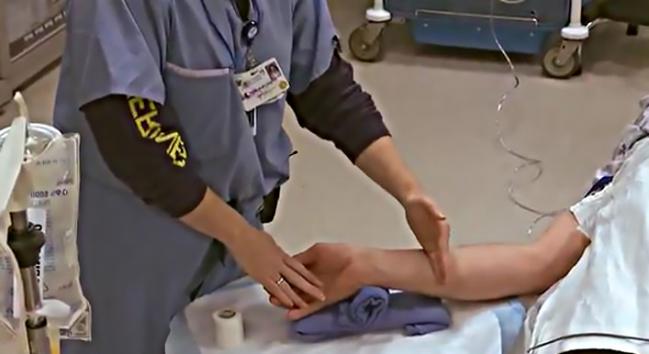Navigating Vascular Access as a Cardiology Fellow
With transradial access on the upswing in the United States, trainees should still master femoral procedures as well, argues one fellow.

For years transfemoral access was the predominant approach for cardiac procedures, but transradial cardiac interventions have recently gained substantial and rapid growth in the United States. Compared with transfemoral procedures, transradial ones are associated with significantly lower risks of major bleeding and vascular complications as well as greater patient comfort and faster recovery times, with early ambulation and shorter hospital stays. Studies have even shown a mortality benefit with radial versus femoral access in select patients with ACS.
With expanding growth and interest in transradial access, the proportion of routine transfemoral interventions seems to be dwindling down, with some even questioning the ethics of a femoral-first PCI approach. Studies have shown that university programs have higher than the national average of transradial procedures, and that leads me to question whether fellows are receiving enough transfemoral training.
Despite its decreasing use, femoral access remains one of the most versatile and accommodating of approaches. It is routinely preferred for complex coronary interventions requiring strong catheter support and maneuverability. Mechanical circulatory support devices including ECMO and structural interventions require large-bore access for which transfemoral is the first choice. Therefore, I think transfemoral access and management are incredibly important skills to learn and master.
Transradial interventions offer their own challenges for invasive coronary procedures. Although they come with a much safer risk profile, transradial procedures have a slower learning curve, longer procedural times, and are associated with greater radiation exposure, especially in new operators. Catheter manipulation is often technically challenging and guide support sometimes inadequate.
All things considered, it has become quite clear that good operators should be adept at performing all approaches. Yet, navigating this maze of access options, closure devices, techniques, and pitfalls can be tricky for fellows, and from my experience, vascular access and management are often neglected parts of cardiovascular procedures. I’ve often seen postprocedural access management left to cath lab technicians.
During my fellowship (full disclosure: my institution is radial heavy), here’s what I have learned about transfemoral access. First, you have to respect it as it will give you great support and access for complex/large-bore interventions in situations where you need it. However, keep in mind that it comes with a risk of major vascular problems.
Next, know your anatomy and landmarks before even attempting to access the artery. You can either use the inguinal ligament landmarks—not inguinal crease—or marking the femoral head by fluoroscopy (my preference) to guide the puncture height. Elderly patients with a high probability of peripheral arterial disease and calcified tortuous vessels will benefit from additional ultrasound guidance that can identify the common femoral artery and bifurcation. Also, routine ultrasound has been shown to significantly reduce the incidence of pseudoaneurysms and major bleeds. Micropuncture techniques can be used in select cases especially with small, calcified vessels that are readily identified on ultrasound.
A postprocedural shot of the femoral artery with the sheath in place—RAO view to better look at femoral artery bifurcation and LAO to identify site of sheath entry—is effective in revealing complications early and helps you to choose access closure modality. Fellows should also try to get hands-on experience with different closure devices, both to be able to appreciate good hemostatic techniques and also to learn about troubleshooting and preventing complications. One of the most reliable methods to ensure adequate hemostasis remains good old manual compression, which can be used when other modalities fail.
On the other hand, all of today’s evidence suggests that a “radial-first” approach whenever feasible will reduce access-site complications. Fellows should therefore be motivated to understand the challenges and learn the management of radial approach interventions as well.
The key is: practice, practice, practice! I’ve found that the best way to do this is to participate in as many cases with experienced operators as possible and to identify problems and troubleshoot difficult scenarios including overcoming unfavorable vascular anatomy/tortuosity and choosing the right equipment. Access management is again important here to avoid radial artery complications including spasm and longer-term occlusions. Adequate moderate sedation and a cocktail of vasodilators along with heparin load is usually administered to avoid radial artery spasm. A heparin loading dose soon after acquiring access and postprocedural patent hemostasis are some essential techniques you should master to avoid radial artery occlusion.
As my mentor would say, “an interventional cardiologist’s training never ends.” After becoming proficient in these basic approaches, the field remains open for the ambitious interventionalist to try alternate accesses, including distal transradial (anatomical snuffbox) to large-bore access with transaxillary/transcaval approach. Each method has its merits and challenges, and trainees should learn to identify the right patients for the right approach, familiarize themselves with access management, and understand the techniques and pitfalls of each for the best clinical results.
Photo Credit: Turi Z. Radial artery access: technique, results, and complications. Presented at: Fellows 2012. April 20, 2012.
2018-2019 Fellow Talk Blogger
Udit is a third-year general cardiology fellow at the University of South Dakota (Sioux Falls) who…
Read Full Bio

Comments